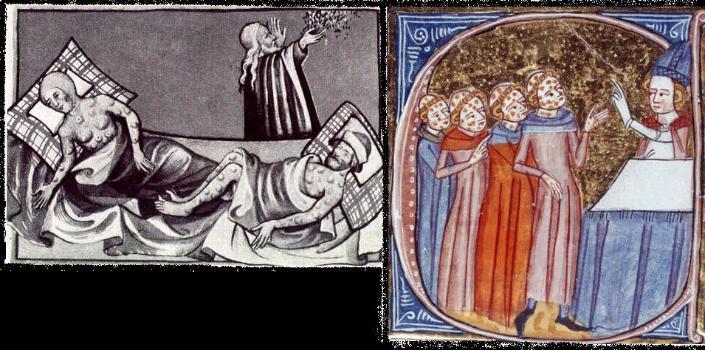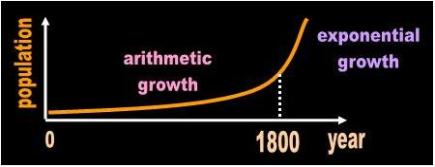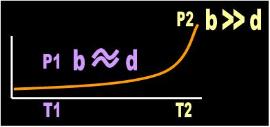- 2.0 The Curve of Life
The UN website lists a handful of researchers that have attempted to calculate the population of the Earth in the distant past. [1]
Regression analysis is a murky science when applied to demography, but this is all we have. If these experts are correct, there
were anywhere from 1 to 10 million people on the planet at the start of civilization, 10,000 years B.C. Few demographer should
feel uncomfortable with this estimate considering that it involves such a wide range. By the year 0, population seems to have
climbed to 200 million, in the year 1000 it was chugging along at 300 million, and 800 years later we finally reached a billion.
Hence, it took humans 1800 years to grow arithmetically from two hundred million to 1 billion. Then, from 1800 onwards, the
population seems to have exploded. We went from 1 billion to over 6 billion. Clearly, something happened that triggered the
exponential growth of our species (Fig. 1).
- ________________________________________________________________________________________
- Last modified 03/03/08
- Copyright © by Nila Gaede 2008

| All species eventually conquer the invisible bugs that keep their numbers back |
| Adapted for the Internet from: Why God Doesn't Exist |
- So what could have been responsible for such inordinate mortality? Were lions still pouncing upon us?
The layman brainstorms the usual host of causes and agents that stopped us from expanding: predators, environmental
changes, acts of God, starvation, war, and disease. What else could have checked our unmitigated advance?
But then which of these factors was it that had the greatest impact?
The demographers seem to have reached consensus on this issue: the number one agent holding our numbers back was
disease, specifically mass diseases. Viruses and bacteria did what no army or earthquake or tsunami could. They attacked
thousands of individuals simultaneously, unnoticed, and with lethal precision. Even in wars most people mostly die of
disease and not in battle. Diseases relentlessly mowed humans down even in times of peace and specifically targeted the
very young.
Diamond [2] believes that the origin of mass diseases can be traced to the start of civilization (i.e., the agricultural phase).
Domestication of plants and animals enabled Man to inherit the best of both worlds -- animals and plants -- and become
the first ‘omnivore’ to rule the planet. The first 'pets' that we domesticated were the chickens, pigs, cows, horses, dogs,
cats, lamas, camels, sheep, and goats. Unfortunately, when these animals are confined in high densities, endemic viruses
and bacteria have a field day and multiply. Some of these diseases mutate and find a better host in the masters themselves.
The plague is an example of a crowd disease that did not get along with its host. It is believed by many that bubonic plague
is responsible for wiping out from a third to a half of the population of Europe from 1348 to 1352. No wars or natural
accidents even remotely erased such high percentages of humans from the face of the Earth. The first crowd diseases to
emerge were likely those that chose a physically easy mechanism for transmission: those that were airborne, those that
were transferred to us by fleas, ticks, and mosquitoes, and those that swam in our drinks. They include some of the famed
childhood diseases: smallpox, chicken pox, measles, mumps, whooping cough, and scarlet fever.
Until the beginning of the 19th Century crowd diseases are said to have accounted for the deaths of as many as 50% of
the children under the age of 5. [3] [4] Children that survived still had to face a host of standbys throughout the rest of
their lives, the likes of tuberculosis, typhus, typhoid fever, dengue, yellow fever, malaria, salmonella, anthrax, polio,
bubonic plague, syphilis, and leprosy just to name a few. We tend to forget that our forefathers stared at death in the face
much more often than we do. Hence, it did not matter that women had lots of babies throughout the agricultural epoch if
few of these survived to an age where they could have children of their own.
This situation changed dramatically at the beginning of the 19th Century with the introduction of vaccines and improvements
in living conditions. Children that would have otherwise died now lived to reproduced children of their own, and adults who
would have otherwise died early now fulfilled their natural life spans. Suddenly, the population, as well as the average age of
the population, increased dramatically in what were fated to become the most advanced nations. Neither the young nor the
old died, and the high pregnancy trend did not subside until after the middle of the 20th Century. Hence, for the thousand
years leading up to the 19th Century we have two trends. One a flat curve marked by high birth and death rates and another
marked by high birth, low death rates (Fig. 2). These numbers suggest that disease is the main agent that accounts for the
two demographic trends just analyzed and that vaccines and better living conditions accelerated the conquest of our last
natural enemies.
Fig. 1 Arithmetic and exponential demographic growth |
Fig. 9.4 Arithmetic (b≈d) and exponential (b»d) demographic growth
- We should, however, be careful not to overestimate the muscle of artificial selection. The geometric expansion would have
happened eventually even in the absence of vaccines. By the 19th Century, Man was already on the road to conquering
these invisible enemies through natural means. For example, smallpox is regarded by many to be the greatest killer of all
time. [5] This disease had apparently been around at least since the reign of Pharaoh Ramses V who is said to have died
of its effects. [6] The bible mentions boils and blains (Exodus 9:8 - 9:11; Job 2:7), indicating that the ancients were familiar
with such symptoms. It is also probable that Pericles died of a smallpox-like disease during the siege of Athens. [7] Some
of these diseases may have mutated over time and caused different symptoms in those days. This may explain the
disagreement among contemporary historiographers as to which disease affected a particular region in the past. What is
indisputable is that, by the 15th Century, Eurasians had settled into an uneasy truce with smallpox whereas the native
populations of the Americas had yet to experience their first case. [8] The reason for this disparity is that the Americas
lacked cattle, the likely source of smallpox. Thus, the naturally immunized conquistadors of the 15th Century watched in
amazement as the ‘Indians’ succumbed to the divine, invisible agent that discriminated between the holy and the
heathen. [9] [10] This experiment would be repeated over and over in the colonization of several Pacific Islands. [11]
Therefore, humans were already acquiring natural immunity to smallpox and other diseases before the discovery of
vaccines, and we can safely conjecture that, had we conquered the microbes through natural selection, the population
would have later expanded exponentially anyways. Exponential growth was simply unavoidable. It was in the cards the
moment Mother Nature was pregnant with Man.
There are three lessons to be gleaned from these facts:
- • Man’s conquest of disease was inevitable.
• Therefore, our exponential demographic phase was in retrospect predictable and inevitable.
• Plants and animals also adapt to diseases and enter an exponential demographic phase.
Skeptics may have trouble with my last conclusion, so I’ll pitch in a little bit of evidence. It is well established that animals
have developed immunities to diseases that devastate humans and other animals. Snakes are practically immune to
salmonella, [12] macaque monkeys are largely unaffected by Herpes B Virus, [13] and fleas and rats have reached an
agreement with the bubonic plague. [14] Plants are plagued with all types of diseases, [15] yet they manage to develop
natural resistances. [16] [17] This suggests a lengthy period of adaptation between host and guest. What I am getting at
is that Dimetrodon, T-Rex, and Neanderthal were no different. Exposure to transmittable diseases would have eventually
resulted in increased resistance. Immunity or partial immunity would have given these species the ability to increase
faster. Some dinosaur and Neanderthal bones exhibit signs of arthritis, an ailment of old age, indicating that individuals
were attaining their natural life spans. Some analysts calculate that in order to grow so large, the sauropods had to have
lived nearly 100 years. These facts imply that the species as a whole had apparently managed to build up its immunities.
The epidemiologists may argue that new diseases or mutated strains irremediably fill the vacuum:
- “ Pathogens are evolving ways to combat our control methods…We’re going to have
to run as fast as we can to stay in the same place.” [18]
“ In the 1970s, eminent people were saying it was the end of the infectious disease era.
We now find after the experience of the 1980s and 1990s, we are sadder and wiser.” [19]
“ Influenza, which killed 20 million people in the year after the end of the first world war,
is still a killer and has the capacity to change rapidly and spread widely throughout
the world. Two attributes of the influenza virus – its potential for rapid genetic change
and its ease of transmission – make it a continued threat that is often overlooked and
underestimated.” [20]
Therefore, if you’re wondering why we still have polio or the flu, or why there are different strains of AIDS, the
epidemiologist has a ready answer. We are forever struggling with diseases and have no guarantees that tomorrow
we won’t be decimated by a post-virus bug.
The conclusions of these experts are myths as far as demography is concerned. In developed nations people no longer
die of smallpox or malaria. They die of poor circulation, cancer, and other ‘diseases’ of old age. But even assuming that
contagious diseases were to make a comeback, once the main strains have been neutralized and population is in the
exponential phase, new diseases and mutated strains affect only a tiny fraction of the population. Most of the severe
infectious disease cases are in Africa, and even there they have no chance of causing a dent in population. Referring to
Sub-Saharan Africa, Bongaarts concludes:
According to the U.N., despite that millions will die of AIDS in Africa, the nine most affected nations will almost double in
size by the year 2050. [22] Similarly, flu [23] and polio [24] viruses are known to have mutated. Should you be worried?
Of course not! Today they claim a negligible portion of the world population:
- " Four million people have healthcare infections every year in the EU. Out of that
figure, 35,000 die... We consider antimicrobial resistance or AMR as one of the
major challenges for public health." [25]
You have as much chance of catching a virulent disease such as mutated polio as you have of winning the lottery. [26]
For all practical purposes, contagious diseases are a thing of the past. They are the least likely candidates to wipe out
humanity in the future. Diseases are a problem only for epidemiologists tasked with minimizing the impact of epidemics
and of new strains.
To summarize, whereas in the past, it was the microscopic bugs that held our numbers in check, once we discovered
them with our microscope, we slaughtered the last natural enemies we had on the planet. We would have eventually
conquered them anyways through natural selection. Instead, we attained this goal much quicker using our intelligence
and skills. This is a quantitative issue of time and not a qualitative issue of ‘whether’. Today, we are home free. Any new
bug that arises has at most the potential to take out a small fraction of the population before we annihilate it under the
microscope. Even in smallpox’s heyday, it had no chance of wiping out the entire population of Earth. We have for all
practical purposes defeated the last enemy that all species eventually overcome. The conquest of disease indicates a
long acclimatization process with viruses and bacteria. Therefore, it necessarily occurs towards the end of a species’
life cycle.
But then, if we eliminated disease, which is what kept our numbers in check, why did the population of humans stop
growing exponentially? Why is the population of our species growing at a slower rate?
Fig. 2 |

| This graph more or less depicts the 2000-year demographic history of Man. We grew more orless arithmetically until we reached the 1-billion mark around 1820. Afterwards Man entered an exponential regime. Consensus is that during most of the agricultural phase (i.e., the |
| last 10,000 years) women had a high fertility rate. In spite of this, the population did not increase exponentially. The demographers believe that our high birth rates were offset by high mortality. |

| At time T1 population P1 was characterized by a regime in which deaths balance out births. Population increases very slowly. The period of exponential growth T2, in contrast, is distinguished by a dramatic drop in deaths. |
| Exponential growth occurs when children that would have otherwise died before reaching puberty now reach maturity and produce children of their own. Compounding this growth is a non-trivial arithmetic component: an increase in the average life span of a human. Both factors are health-related (i.e., improved living conditions and eradication of contagious diseases.) |
- Module main page: The mechanism behind background extinctions
Pages in this module:
- 1. The three population curves
2. This page: All species eventually conquer the invisible bugs that keep their numbers back
3. Not education, but urbanization causes infertility
4. Urban women have no freedom to choose whether to have a baby
5. An urban woman doesn't have the privilege or need to have a family
6. Density is what overturns a pyramid
7. Urbanization was inevitable
